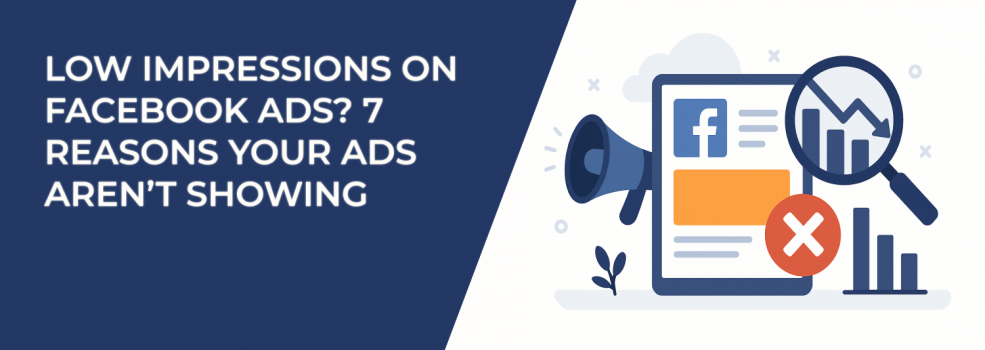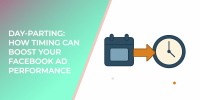You’ve set up a Facebook campaign. The targeting looks right, the creative feels sharp, and the budget is in place. But then you check your results — and the impressions are shockingly low. Sometimes the ads don’t even show at all.
This problem is more common than most advertisers realize. Low impressions on Facebook ads can happen for several reasons, ranging from overly restrictive targeting to simple budget missteps. The good news? Each of these problems has a solution.
Let’s walk through the seven most common reasons your Facebook ads aren’t showing, with practical tips to fix them.
1. Your Audience Is Too Narrow
When impressions are low, one of the first things to check is audience size. Facebook needs a wide enough pool of users to deliver your ads efficiently. If your targeting is extremely narrow, the system can struggle to match your ad with available inventory.
Think of it like fishing in a tiny pond. The chances of catching something drop because there just aren’t enough fish.
Signs your audience might be too narrow:
-
You’ve layered too many interests and behaviors together.
-
You’re restricting age, gender, or location too tightly.
-
The estimated audience size in Ads Manager is under 10,000.
What to do instead: start broader and let the algorithm optimize. Combine a few interests instead of stacking dozens. If you’re worried about wasting spend, monitor performance closely and refine as you go. A healthy starting point for most campaigns is an audience size of at least 500,000 people.
Related reading: Facebook Ads Audience Too Narrow? How to Troubleshoot a Limited Audience.
2. Your Bid or Budget Is Too Low
Facebook runs ads through an auction. That means your ad competes against others targeting the same people. If your budget is small or your bidding strategy is too cautious, you may simply lose the auction. And if you lose often enough, your impressions will drop to almost nothing.
How to check:
Look at your “Delivery” column in Ads Manager. If you see “Limited” or “Learning Limited,” chances are your budget isn’t competitive.
What to try:
-
Increase your daily budget gradually (by 20 — 30% at a time).
-
Test different bid strategies. For example, move from “lowest cost” to “cost cap” to gain more control.
-
Avoid spreading your budget too thin across many ad sets.
Related reading: Daily vs Lifetime Budgets: What's Better for Facebook Campaign Performance?
3. Your Ad Is Stuck in Review
All ads go through Facebook’s review process. Most reviews take less than 24 hours, but some ads can get stuck for days — especially if they fall into categories like housing, finance, or health.
How to handle it:
-
Be patient for at least 24 hours.
-
If an ad is still in review after 48 hours, duplicate it and resubmit.
-
Double-check that your ad complies with Facebook’s advertising policies.
Related reading: What to Do When Your Facebook Ads Are Disapproved: A Complete Guide.
4. Poor Relevance or Low Quality
Facebook rewards ads that users engage with. If your ad receives negative feedback, has blurry or low-quality visuals, or doesn’t resonate with the audience, Facebook will deprioritize it.
How to improve relevance:
-
Use sharp, professional-looking images or videos.
-
Keep copy short, clear, and benefit-driven.
-
Match your creative with your audience’s intent.
Refreshing your creative regularly helps too. Even great ads fatigue over time.
5. You Have Overlapping Audiences
If multiple ad sets are targeting the same people, your ads end up competing with each other. This is known as audience overlap.
How to fix it:
-
Consolidate campaigns to avoid internal competition.
-
Use exclusions so your warm and cold audiences don’t mix.
-
Separate campaigns for prospecting and retargeting.
Related reading: The Role of Audience Overlap in Facebook Ads Performance.
6. Campaign Settings Are Too Restrictive
Sometimes low impressions have nothing to do with your creative or budget — it’s simply the way your campaign is set up.
Common mistakes include:
-
Running ads only at very limited hours.
-
Choosing only one placement instead of “Automatic Placements.”
-
Adding unnecessary restrictions like device type.
Loosening these restrictions usually helps unlock delivery.
7. Competition Is Fierce
Even if you do everything right, competition matters. During high-demand periods — such as Black Friday, holiday shopping, or election seasons — advertisers flood Facebook with campaigns. The result? Higher CPMs and fewer impressions for smaller budgets.
What you can do:
-
Shift campaigns to less competitive days.
-
Focus on warm audiences.
-
Test alternative campaign objectives.
When competition peaks, the smartest move is often to rethink timing and strategy rather than push your budget beyond its limits.
Final Thoughts
Low impressions on Facebook ads are rarely random. Most of the time, they’re signals — pointing you to audience issues, budget problems, or stiff competition.
By diagnosing each step, you can spot where your campaign is stuck and make the right adjustments. Facebook wants advertisers to succeed because strong ads keep people engaged on the platform. That means when you fix delivery issues, you’re rewarded with more impressions and often lower costs.
Want to dive deeper into campaign troubleshooting? Check out Understanding Facebook Ad Statuses: Common Issues and How to Fix Them.

